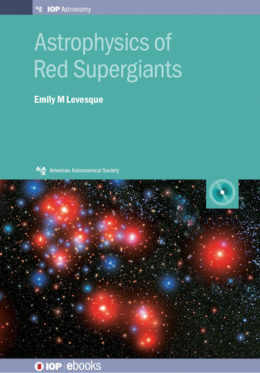The American Astronomical Society recently launched a new partnership with IOP to produce a series of ebooks about astronomy and astrophysics. The first book in this line, Astrophysics of Red Supergiants, is authored by Dr. Emily Levesque, assistant professor in the astronomy department at the University of Washington and 2014 winner of the AAS’s Annie Jump Cannon Award, and it’s now available for download with an institutional IOP ebook subscription.
What is Astrophysics of Red Supergiants about, and why might you want to check it out? Dr. Levesque held a webinar last month (which was recorded and can be accessed here) to share more about the content of her new ebook.
What is a Red Supergiant?
A red supergiant occurs when a moderately massive star — perhaps 8–40 solar masses in size — exhausts its hydrogen fuel, evolves off of the main sequence, and transitions to fusing helium within its core. As this occurs, the star’s radius expands, causing its temperature to plummet. Red supergiants are among the coldest and most physically massive stars known.
Why Do We Care About Red Supergiants?
Studying red supergiants can help us to expand our knowledge in a broad range of astrophysical fields. This includes:
- Gravitational waves
The colliding neutron stars that produce gravitational waves likely evolved from red supergiants in binaries. We can therefore use such mergers to learn about red supergiants in the final stages of their lives — as well as use what we know about red supergiants to constrain expected gravitational wave signals. - Supernovae
Red supergiants are the progenitors that produce some types of supernovae. For this reason, it’s critical that we understand red supergiant evolution so that we can better model the moments leading up to supernova explosion, and better interpret pre-explosion observations of supernovae. - Strange and variable stars
Many red supergiants show photometric and spectroscopic variability, and we’re still working to understand why. The long list of possible mechanisms that produce variability includes large-scale convection, radial pulsation, sporadic mass loss, changes in the amount and distribution of circumstellar dust, hydrostatic instabilities, and binary companions (which can produce variability via eclipses, mass transfer, wind interactions, etc.). There may also be new physics that we don’t yet know about!
What Can You Learn from Astrophysics of Red Supergiants?
Dr. Levesque’s compact book — only 100 pages long — is written at an advanced graduate-student level and provides a complete primer on the current state of red supergiant astronomy. Chapters in the book include:
- An Introduction to Red Supergiants
- Inside a Red Supergiant
- Physical Properties of Red Supergiants
- Mass Loss and Dust Production in Red Supergiants
- Red Supergiants in Binaries
- Red Supergiants in and beyond the Milky Way
- Variability in Red Supergiants
- Red Supergiants and Supernovae
- The Future of Red Supergiant Research
More Information
Astrophysics of Red Supergiants ebook download: http://iopscience.iop.org/book/978-0-7503-1329-2
Dr. Levesque’s webinar: http://iopscience.iop.org/bookListInfo/author-webinars#Astrophysics%20of%20Red%20Supergiants
If you plan to be at AAS 231, come by to meet Dr. Levesque and celebrate the launch of the new AAS/IOP ebook series with us at the AAS booth (#315) on Wednesday, 10 January at 5:30 p.m. during the poster session!
To learn more about the new AAS/IOP ebook partnership and current and upcoming titles, visit http://iopscience.iop.org/bookListInfo/aas-iop-astronomy#collections.


8 Comments
Pingback: Judging a book by its cover: estimating red supergiant masses from their surface abundance | astrobites
Pingback: A New Look at SN 1987A | astrobites
Pingback: House Carnival # 644 – Next Gadget
Pingback: Area Carnival # 643 – Next Gadget
Pingback: House Carnival # 643 – Technology Workshop
Pingback: Faculty/staff honors: Honorary doctorate, early career award, Washington state LGTBQ Commission, writing program praise – UW News – ResumeLord
Pingback: Observations of Betelgeuse’s Dimming from the Stratosphere
Pingback: Meet the AAS Keynote Speakers: Dr. Roberta Humphreys | astrobites